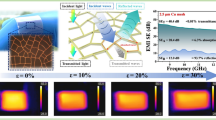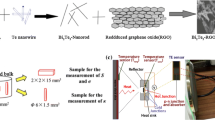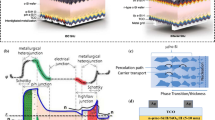Abstract
This paper presents a resistor-less high-order curvature compensation bandgap voltage reference. A high-order curvature compensation is based on generating successive VGS voltages with different temperature characteristics, which are used to cancel thermal nonlinearity the first- and higher-order terms of the transistor voltage VEB. At the same time, a piecewise-linear curvature compensation circuit is used to broaden the temperature range of the whole circuit and achieve low-temperature coefficient. The proposed bandgap reference was designed using standard CSMC 0.18-μm CMOS technology. Simulation results indicate that the proposed bandgap reference achieves the best temperature coefficient of 2.37 ppm/°C from − 40 to 125 °C with a supply voltage of 5 V. The BGR output is about 1.1881 V and a − 60.7-dB PSRR at 10 kHz while only consuming 200 μW.















Similar content being viewed by others
Data Availability
The datasets generated during and/or analyzed during the current study are available from the corresponding author on reasonable request.
References
H.-M. Chen, K.-H. Lin, C.-C. Chen, in A 1.33 ppm/°C Precision Bandgap Reference with Piecewise-Linear Curvature Compensation. 2020 IEEE International Conference on Consumer Electronics—Taiwan (ICCE-Taiwan) (2020), pp. 1–2
K. Chen, L. Petruzzi, R. Hulfachor, A 1.16-V 5.8-to-13.5-ppm/°C curvature-compensated CMOS bandgap reference circuit with a shared offset-cancellation method for internal amplifiers. IEEE J. Solid-State Circuits 56(1), 267–276 (2021)
Y.-H. Chung, J.-F. Shih, Y.-H. Wang, in A Resistor-Less CMOS Bandgap Reference with High-Order Temperature Compensation. 2021 IEEE Asia Pacific Conference on Circuit and Systems (APCCAS) (2021), pp. 1–4
W. Huang, L. Liu, Z. Zhu, A sub-200nW all-in-one bandgap voltage and current reference without amplifiers. IEEE Trans. Circuits Syst. II Express Briefs 68(1), 121–125 (2021)
O.-E. Mattia, H. Klimach, S. Bampi, in 0.7 V Supply Self-Biased Nano Watt MOS-Only Threshold Voltage Monitor. 2015 IEEE International Symposium on Circuits and Systems (ISCAS) (2015), pp. 497–500
X. Ming, L. Hu, Y.-L. Xin, A high-precision resistor-less CMOS compensated bandgap reference based on successive voltage-step compensation. IEEE Trans. Circuits Syst. I Regul. Pap. 65(12), 4086–4096 (2018)
I.-C. Necula, C.-R. Popa, in Voltage Reference with Second Order Curvature Correction. 2014 International Semiconductor Conference (CAS) (2014), pp. 251–254
R. Nagulapalli, R.K. Palani, K. Hayatleh, in A 0.82 V Supply and 23.4 ppm/°C Current Mirror Assisted Bandgap Reference. 2021 32nd Irish Signals and Systems Conference (ISSC) (2021), pp. 1–4
R. Nagulapalli, R.K. Palani, S. Agarwal, in A 15uW, 12 ppm/°C Curvature Compensated Bandgap in 0.85V Supply. 2021 IEEE International Symposium on Circuits and Systems (ISCAS) (2021), pp. 1–4
R. Nagulapalli, K. Hayatleh, S. Barker, in A Single BJT 10.2 ppm/°C Bandgap Reference in 45nm CMOS Technology. 2020 11th International Conference on Computing, Communication and Networking Technologies (ICCCNT) (2020), pp. 1–4
S.H. Qin, Y.G. Hu, Y.B. Hu, A high PSRR resistor-less bandgap reference source. Microelectronics 47(04), 457–460 (2017)
T. Varun, R. Nagulapalli, I. Raja, in A 82μW Mixed-Mode Sub-1V Bandgap Reference with 25 ppm/°C Temperature Co-efficient with Simultaneous PTAT Generation. 2021 25th International Symposium on VLSI Design and Test (VDAT) (2021), pp. 1–4
S. Wang, P.K.T. Mok, An 8-nW resistor-less bandgap reference based on a single-branch floating PTAT voltage. IEEE Solid-State Circuits Lett. 3, 74–77 (2020)
X. Xin, Y. Hu, J. Cai et al., A 0.6-V, 1.56-nW, 5.87-ppm/°C, 0.23%/V CMOS-only subthreshold voltage reference with the threshold voltage difference. Circuits Syst. Signal Process. 41, 4256–4274 (2022)
Z.-K. Zhou, Y. Shi, Y. Wang, A resistor-less high-precision compensated CMOS bandgap voltage reference. IEEE Trans. Circuits Syst. I Regul. Pap. 66(1), 428–437 (2019)
Z.-K. Zhou, P.-S. Zhu, Y. Shi, A CMOS voltage reference based on mutual compensation of Vtn and Vtp. IEEE Trans. Circuits Syst. II Express Briefs 59(6), 341–345 (2012)
Acknowledgements
This work was supported in part by the National Natural Science Foundation of China under Grant 61650404 and the Science and Technology Project of Jiangxi Provincial Education Department under Grant GJJ201411.
Author information
Authors and Affiliations
Corresponding author
Additional information
Publisher's Note
Springer Nature remains neutral with regard to jurisdictional claims in published maps and institutional affiliations.
Rights and permissions
Springer Nature or its licensor (e.g. a society or other partner) holds exclusive rights to this article under a publishing agreement with the author(s) or other rightsholder(s); author self-archiving of the accepted manuscript version of this article is solely governed by the terms of such publishing agreement and applicable law.
About this article
Cite this article
Feng, X., Wu, H., Huang, L. et al. A High-Order Curvature Compensated CMOS Bandgap Reference Without Resistors. Circuits Syst Signal Process 42, 6444–6459 (2023). https://doi.org/10.1007/s00034-023-02431-1
Received:
Revised:
Accepted:
Published:
Issue Date:
DOI: https://doi.org/10.1007/s00034-023-02431-1




